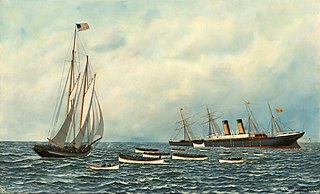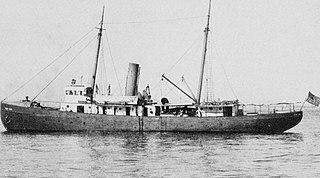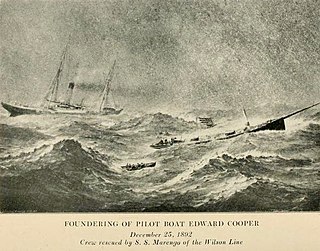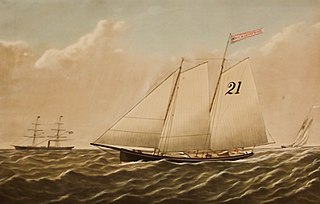
Richard "Dick" Brown was a 19th-century Sandy Hook pilot. Brown was captain for the 19th-century Sandy Hook pilot boat Mary Taylor. At the time of his death he was the oldest of the Sandy Hook pilots having served for 50 years. He was the captain of the racing yacht America, which won the inaugural America's Cup in 1851.

The Sylph was a 19th-century pilot boat first built in 1834, by Whitmore & Holbrook for John Perkins Cushing as a Boston yacht and pilot-boat for merchant and ship owner Robert Bennet Forbes. She won the first recorded American yacht race in 1835. She was a pilot boat in the Boston Harbor in 1836 and 1837 and sold to the New York and Sandy Hook Pilots in October 1837. She was lost in winter of 1857 with all hands during a blizzard off Barnegat, New Jersey. The second Sylph was built in 1865 from a half-model by Dennison J. Lawlor. The third Sylph was built in 1878 at North Weymouth, Massachusetts for Boston Pilots. She was sold out of service in 1901, after 23 years of Boston pilot service.

The Phantom was a 19th-century Sandy Hook pilot boat built in 1867 from the designs by Dennison J. Lawlor. The schooner was considered a model for her type with a reputation for being very fast. She helped rescue the passengers on the steamship SS Oregon when it sank in 1886. She was one of the pilot-boats that was lost in the Great Blizzard of 1888. The Phantom was replaced by the pilot-boat William H. Bateman.

The Washington was a 19th-century Sandy Hook pilot boat built in 1845 by C. & R. Poillon for New York Pilots. She was rebuilt several times, the last with the sail number "22" painted on her mainsail. In 1884, she was sunk by the German steamship Roma, and then replaced by a new Washington.

The New York was the first steam pilot boat in the New York harbor. She was built in 1897, by the Harlan and Hollingsworth company at Wilmington, Delaware for the a group of New York Sandy Hook pilots. She was designed by Archibald Cary Smith, who was a prominent naval architect and marine engineer. The New York was retired from pilot service in 1951.

The Jacob Bell was a 19th century Sandy Hook pilot boat built by the shipbuilder Jacob Bell for a group of New York Pilots in 1840. She was named in honor of the shipbuilder Jacob Bell, who was a partner in the Brown & Bell firm. After fourteen years of service she went ashore in a gale off Sandy Hook in 1854.
The David Mitchell was a 19th century Sandy Hook pilot boat built in 1846 at Baltimore, Maryland, for a group of New York Pilots. She was launched at the John A. Robb shipyard in East Baltimore. She was sold to the Pensacola, Florida pilot fleet in 1875.

The James M. Waterbury was a 19th-century Sandy Hook pilot boat built in 1843, at Williamsburgh, Brooklyn for a group of New York Pilots. She helped on many of the rescues along the New York Harbor. One of last reports of the James M. Waterbury was in 1867 when seaman James Roach fell overboard and was drowned off Fire Island.
The Mary Ann, No. 13 was a 19th-century Sandy Hook pilot boat built for the New York pilots. She helped transport maritime pilots between inbound or outbound ships coming into the New York Harbor. In 1860, the Mary Ann, was one of only twenty-one pilot boats in the New York and New Jersey fleet. She went ashore outside Sandy Hook in 1863.

The Centennial was a 19th-century wood pilot boat built in 1876 by Robert Crosbie and designed by Boston designer Dennison J. Lawlor for New York and New Jersey pilots. She was one of the pilot-boats that survived the Great Blizzard of 1888. By 1898, in the age of steam, she was the last pilot boat left in the fleet; then sold in 1898 to a group in Montego Bay, Jamaica.

The Caprice was a 19th-century Sandy Hook pilot boat built in 1871 by Brown & Lovell in East Boston, Massachusetts for Peter McEnany and other New York pilots. In 1876, she was run down and sank, off Bay Ridge, Brooklyn, by the steamship New Orleans. She was raised and was one of the pilot boats that survived the Great Blizzard of 1888. The Caprice was last reported sailing off the coast of New York in 1891.

The David Carll was a 19th-century pilot boat, built in 1885 at the David Carll shipyard in City Island, New York. She was named in honor of David Carll, a well-known City Island shipbuilder. The David Carll was considered to be among the fastest schooners in the fleet. She was built to replace the Mary E. Fish that was run down and sank by the schooner Frank Harrington in 1885. She was one of the pilot boats that survived the Great Blizzard of 1888. The David Carll was lost at sea in 1893.

The Anthony B. Neilson was a 19th-century Sandy Hook pilot boat, built in 1854 by George Steers for a company of New York Sandy Hook pilots. She was considered to be the fastest boat in the piloting business. She helped transport New York City maritime pilots between inbound or outbound ships coming into the New York Harbor. She survived the Great Blizzard of 1888. In 1859, the Neilson was sold to a group of New Orleans pilots. The New York pilots then replaced the Neilson, with a new pilot boat, the John D. Jones.

The Edward Cooper was a 19th-century Sandy Hook pilot boat, built in 1879 for New York Pilots at Greenpoint, Brooklyn. She was named in honor of the Mayor of New York City. The Edward Cooper helped transport New York City maritime pilots between inbound or outbound ships coming into the New York Harbor. She survived the Great Blizzard of 1888. In 1892, the Cooper sank in a snowstorm and was replaced by the Joseph Pulitzer in 1894.

The William H. Aspinwall was a 19th-century Sandy Hook pilot boat built in 1861 and launched from the J.B & J.D. Van Deusen shipyard at East River for New York Pilots. She was a replacement for the former pilot boat Virginia. In 1880, the Aspinwall was caught in a thick fog and went ashore at the Long Island bar and became a total loss. She was replaced by a new pilot boat, the America, No. 21.
The James Gordon Bennett was a 19th-century two-masted pilot boat, built in 1870 at the Lawrence & Foulks shipyard. She was named in honor of James Gordon Bennett, Jr., publisher of the New York Herald. She went ashore in 1893 and was rebuilt at the C. & R. Poillon shipyard. In 1897, the James Gordon Bennett was bought by Miller J. Morse of the Atlantic Yacht Club and made into a yacht. He changed her name to Hermit. The New Jersey pilots purchased her in 1901, to replace the David T. Leahy, that was run down by the steamship Alene. The Hermit sank in 1906, when the steamship Monterey ran into her.
The Blossom was a 19th-century Sandy Hook pilot boat built for the New York pilots around 1837. She helped transport maritime pilots between inbound or outbound ships coming into the New York Harbor. In 1839, she came across the Slave ship La Amistad. In 1840, there were only eight New York pilot boats, the Blossom being No. 5. Pilot Thomas Freeborn of the Blossom boarded the packet ship John Minturn and tried to guide the ship in bad weather. He was one of thirty-eight passengers that died near the Jersey Shore in 1846.

The Virginia was a 19th-century Sandy Hook pilot boat. She came from Savannah to New York City in 1838. In 1840, the Virginia was No. 8 in the list of only eight pilot boats in the New York fleet. She went ashore in 1860 and was replaced by the pilot boat William H. Aspinwall in 1861.
The E. K. Collins was a 19th-century Sandy Hook pilot boat built in the early 1840s. She was named for the American shipping magnate Edward Knight Collins. During a winter storm, the Collins ran ashore on the outer bar of Fire Island in 1856.

Favorite or Favorita, was a 19th-century New York Sandy Hook pilot boat built in the early 1820s. She helped transport New York City maritime pilots between inbound or outbound ships coming into the New York Harbor. Favorite collided with a United States steamer and sank in 1865 near Barnegat Lighthouse.















